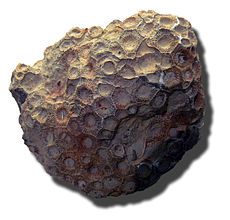Hexagonaria: Difference between revisions
Appearance
Content deleted Content added
added place it can also be found |
Kenvandellen (talk | contribs) m Corrected misspelling of Traverse Group (previously "Transverse"). |
||
| Line 25: | Line 25: | ||
== Species Identification == |
== Species Identification == |
||
Based on Erwin C. Strumm's ''Corals of the |
Based on Erwin C. Strumm's ''Corals of the Traverse Group of Michigan Part 13, Hexagonaria'', published in 1970.<ref name=Strum/> |
||
{| class="wikitable sortable sortable" |
{| class="wikitable sortable sortable" |
||
! scope="col"| Species |
! scope="col"| Species |
||
Revision as of 15:18, 5 June 2019
| Hexagonaria Temporal range: Devonian
| |
|---|---|

| |
| Hexagonaria percarinata | |
| Scientific classification | |
| Domain: | Eukaryota |
| Kingdom: | Animalia |
| Phylum: | Cnidaria |
| Class: | Hexacorallia |
| Subclass: | †Rugosa |
| Order: | †Stauriida |
| Family: | †Disphyllidae |
| Subfamily: | †Hexagonariinae |
| Genus: | †Hexagonaria Gürich, 1896 |
| Species | |
| |
Hexagonaria is a genus of colonial rugose coral. Fossils are found in rock formations dating to the Devonian period, about 350 million years ago. Specimens of Hexagonaria can be found in most of the rock formations of the Traverse Group in Michigan. Fossils of this genus form Petoskey stones, the state stone of Michigan. They have been found in Iowa also.[1]
Hexagonaria is a common constituent of the coral reefs exposed in Devonian Fossil Gorge below the Coralville Lake spillway[2] and in many exposures of the Coralville Formation in the vicinity of Coralville, Iowa.[3]
Species Identification
Based on Erwin C. Strumm's Corals of the Traverse Group of Michigan Part 13, Hexagonaria, published in 1970.[1]
| Species | Corallites (diameter) | Septa (count) |
|---|---|---|
| H. anna | 12–16 mm | 32-44 |
| H. cristata | 16–20 mm | 36-44 |
| H. fusiformis | 6–10 mm | 34-38 |
| H. percarinata | ~10 mm | 38-40 |
| H. alpenensis | 2–6 mm | 26-28 |
| H. subcarinata | 8–12 mm | 30-34 |
| H. attenuate | 8–14 mm | 30-38 |
| H. potterensis | 4–15 mm | 36-38 |
| H. profunda | 13–15 mm | 38-42 |
Image Gallery
-
Hexagonaria mirabilis
-
H. percarinata, "Petoskey stone"
References
- ^ a b Stumm, Erwin C. (19 June 1970), Corals of the Transverse Group of Michigan Part 13, Hexagonaria (PDF), vol. 23, Ann Arbor: The University of Michigan Press, pp. 81–91
- ^ Jean Prior, Devonian Fossil Gorge, Iowa Geological Survey, 1998.
- ^ Brian J. Witzke and Bill J. Bunker, Sedimentation and stratigraphic architecture of a Middle Devonian (late Givetian) transgressive-regressive carbonate-evaporite cycle, Coralville Formation, Iowa area, Paleozoic Sequence Stratigraphy, Biostratrigraphy and Biogeology, Special Paper 321, Geological Society of America, 1997.
- "Hexagonaria". The Paleobiology Database. Archived from the original on 20 July 2011. Retrieved 27 February 2010.
{{cite web}}: Unknown parameter|dead-url=ignored (|url-status=suggested) (help)
Further reading
Look up Hexagonaria in Wiktionary, the free dictionary.
Wikimedia Commons has media related to Hexagonaria.


